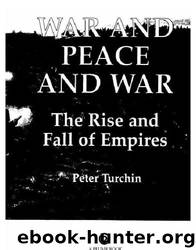War and Peace and War by Turchin Peter

Author:Turchin, Peter
Language: eng
Format: epub
Publisher: PENGUIN group
Part II
IMPERIOPATHOSIS
The Fall of Empires
Chapter 8
The Other Side of the Wheel of Fortune
From the Glorious Thirteenth Century into the Abyss of the Fourteenth
“I am in Paris, in the royal city where abundance of natural wealth not only holds those who live there, but also attracts those from afar. Just as the moon outshines the stars in brilliance, so does this city, the seat of monarchy, lift her head above the rest.” Thus wrote Gui de Bazoches, a chronicler from Champagne who visited Paris during the reign of Philip II Augustus (1180-1223).
The thirteenth century was the golden age of medieval France. The territory controlled directly by the French crown tripled between 1200 and 1300. The territorial explosion of France began under Philip Augustus, who took away all French possessions of the Plantagenets, except Aquitaine. Southern France was acquired under his successor Louis IX (St. Louis) as a result of the Albigenisan crusades. By 1300, France came to dominate Western Europe militarily, politically, and culturally. To the east, the once formidable German Empire had disintegrated, leaving a multitude of city-states and tiny principalities. To the south, the resurgent Castile was still preoccupied with its Reconquista against the Iberian Moors. Castile’s time of greatness was still two centuries in the future. France’s only significant rival was England. But the population of England was only one fourth of France’s, and the income of the English Plantagenets was a fraction of that of the French Capetians. The population of France was more than 20 million—every third inhabitant of Western Europe owed allegiance to the French king.
The city of Paris with its 230,000 people was by far the largest and most splendid city of Latin Christendom. The cultural predominance of France during the High Middle Ages cannot be overstated. The Gothic style of architecture, known to the contemporaries as the French style, developed in Ile-de- France and spread from there to England, Germany, Spain, and northern Italy. During the thirteenth century, the University of Paris became the main center of learning and philosophy in Europe, attracting the best thinkers of the age: Albertus Magnus of Germany, Thomas Aquinas of Italy, and Duns Scotus of Scotland. Although Latin still reigned as the language of learning and international diplomacy, French became the most important vernacular language in Europe. It was spoken by the nobilities of England, Flanders, the kingdom of Naples and Sicily, in the remnants of the kingdom of Jerusalem, and, after 1310, in Hungary
When the fourteenth century opened, wrote the historian Barbara Tuchman in A Distant Mirror, the superiority of the French in chivalry, learning, and Christian devotion was taken for granted. Gerald of Wales acknowledged that “the fame of French knights dominates the world.” The Spanish knight Don Pero Ninõ described the French as “generous and great givers of presents ... very gay, giving themselves up to pleasure and seeking it. They are very amorous, women as well as men, and proud of it.” Knights and even monarchs from all over Europe assembled at the
Download
This site does not store any files on its server. We only index and link to content provided by other sites. Please contact the content providers to delete copyright contents if any and email us, we'll remove relevant links or contents immediately.
| Africa | Americas |
| Arctic & Antarctica | Asia |
| Australia & Oceania | Europe |
| Middle East | Russia |
| United States | World |
| Ancient Civilizations | Military |
| Historical Study & Educational Resources |
Cecilia; Or, Memoirs of an Heiress — Volume 1 by Fanny Burney(32436)
Cecilia; Or, Memoirs of an Heiress — Volume 2 by Fanny Burney(31872)
Cecilia; Or, Memoirs of an Heiress — Volume 3 by Fanny Burney(31857)
The Secret History by Donna Tartt(18851)
Sapiens: A Brief History of Humankind by Yuval Noah Harari(14254)
Leonardo da Vinci by Walter Isaacson(13188)
The Radium Girls by Kate Moore(11926)
Sapiens by Yuval Noah Harari(5294)
How Democracies Die by Steven Levitsky & Daniel Ziblatt(5129)
The Wind in My Hair by Masih Alinejad(5034)
Homo Deus: A Brief History of Tomorrow by Yuval Noah Harari(4827)
Endurance: Shackleton's Incredible Voyage by Alfred Lansing(4677)
The Silk Roads by Peter Frankopan(4458)
Man's Search for Meaning by Viktor Frankl(4427)
Millionaire: The Philanderer, Gambler, and Duelist Who Invented Modern Finance by Janet Gleeson(4382)
The Rape of Nanking by Iris Chang(4139)
The Motorcycle Diaries by Ernesto Che Guevara(4016)
Joan of Arc by Mary Gordon(4016)
Hitler in Los Angeles by Steven J. Ross(3901)
